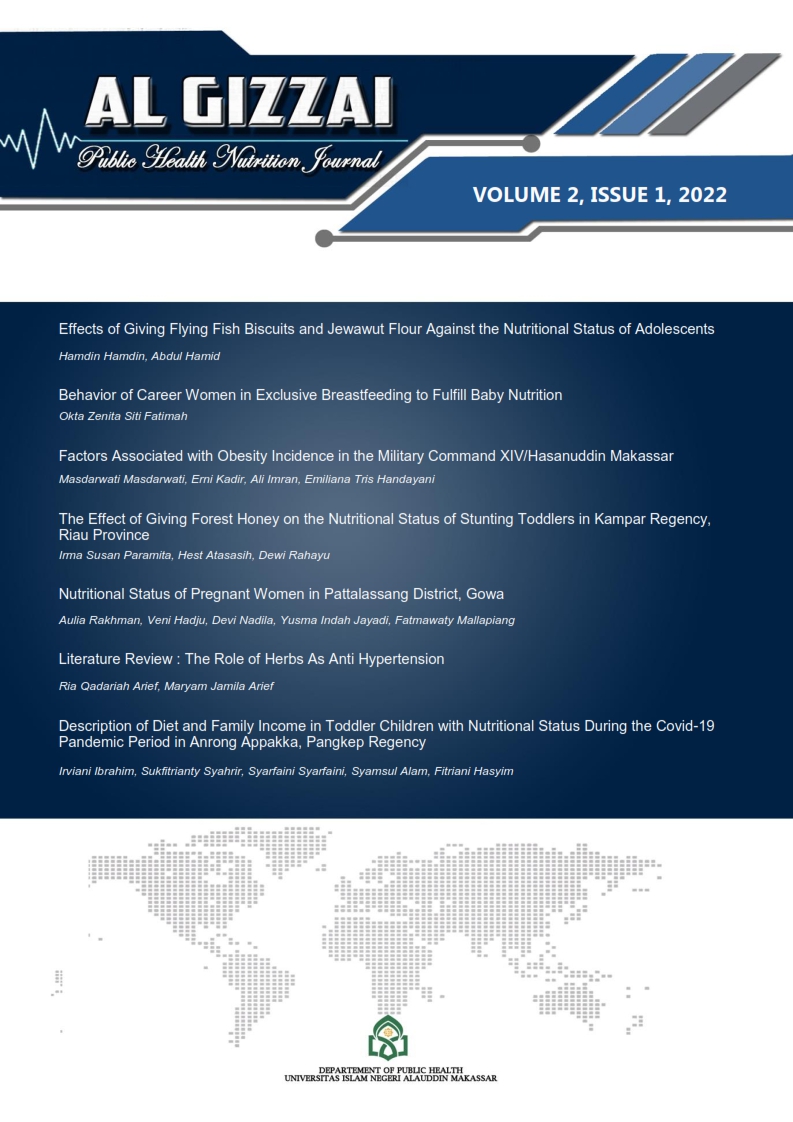The Effect of Giving Forest Honey on the Nutritional Status of Stunting Toddlers in Kampar Regency, Riau Province
Abstract
The problem of short children (stunting) is one of the nutritional problems that still the focus of the government until now. One of the reasons is the lack of nutritional consumption in children for 24-59 months will have an impact on their growth and development. Therefore, nutritional intake must contain complete nutrition and all these nutrients can be obtained from honey. Honey can help the body to maintain health and can stimulate appetite, as well as improve nutritional status.
The purpose of this study was to determine the effect of giving honey on the nutritional status of stunting toddlers in Kampar district. The number of samples in this study was 25 toddlers The specific target to be achieved is a change in nutritional status and changes in appetite for toddlers by giving honey regularly twice a day as much as 20 grams per day, 10 grams in the morning and 10 grams per day during 30 days. The type of honey given is forest honey from Kampar Regency. The research method used in this study is a quasi-experimental research method with a One group pre-post test design. The research location was conducted in Ranah Singkuang Village, Kampar Regency. This research was conducted in March-April 2021.
The results showed that there was an increase in nutritional status based on the indicator of height for age (TB/U), p value = 0.047, although not significant. However, offering honey has not been able to improve the nutritional status of toddlers based on indicators of weight for age (W/U). This is presumably due to many factors, one of which is the consumption of nutrients, especially energy and protein, which is still low, which is below the recommended evaluation. Even the average level of energy consumption is still below 70% of the estimated figure, meaning that it is still below the basal metabolic requirement, so that all energy consumption is used to meet the body's metabolic needs. The low level of energy and protein consumption causes weight gain during the intervention period has not been able to improve the nutritional status of children based on weight for age.
References
Almatsier. S. 2004.Prinsip Dasar Ilmu Gizi. Gramedia Pustaka Utama. Jakarta. Hal: 82-102.
Balitbankes (2013) Riset Kesehatan Dasar 2013. Kementerian Kesehatan Republik Indonesia.
Balitbankes (2018) Riset Kesehatan Dasar 2018. Kementerian Kesehatan Republik Indonesia.
Barker DJP (2008) Nutrition in The Womb : How Better Nutrition During Development Will Prevent Heart Disease, Diabetes, and Stroke. USA: The Barker Foundation.
Dewa, I. Nyoman (2002). Penelilaian Status Gizi. Jakarta, Penerbit EGC.
Hamidi, M.N. S.. 2014.Hubungan Pemberian Madu Terhadap Nafsu Makan Pada Balita Di Disa Ranah Kecamatan Kampar Kabupaten Kampar
Harmiyati, et al. 2017. The Impact of Honey change in Nutritional Status in Children with Poor Nutrition. Bellitung Nursing Journal.
Kementerian Kesehatan RI (2012) Kerangka Kebijakan Gerakan Nasional Sadar Gizi dalam Rangka Seribu Hari Pertama Kehidupan (Gerakan 1000 HPK).
Supariasa, I Nyoman. 2012. Penilaian Status Gizi Buku Kedokteran EGC: Jakarta
WHO (2010) Nutrition Landscape Information System (NLIS) Country Profile
Lameshow (1991) Sample size determination in health studies : a practical manual. Geneva: WHO.
Lolita, N. 2015. Pengaruh Pemberian Madu Tehadap Status Gizi Balita Di Desa Tobing Jae Kecamatan Huristak Kabupaten Padang Lawas Tahun 2015
Nugraeni, L. 2015. Pengaruh pemberian madu terhadap status gizi balita di desa Tobing Jae Kecamatan huristak kabupaten padang lawas. Jurnal Maternal neonatal USM Indoensia.
Peraturan Mentri Kesehatan No 2 Th 2020 Standar Antropometri Anak
Umi khalifah. 2016 The Factor’s related with Appetite at Home of Student’s Fourth Grade at Madrasah Ibtidaiyah Pembangunan UIN Jakarta in 2015. Thesis. Fakultas Kedokteran dan Ilmu Kesehatan program studi Ilmu Kesehatan Masyarakat Universitas Islam Negeri Jakarta.
Unicef (2013) Improving Child Nutrition The Achievable Imperative for Globl Progress. Available at www.unicef.org/publications/index.html
WHO (2010) Nutrition Landscape Information System (NLIS) Country Profile Indicators: Interpretation Guide. Geneva: WHO Document Production Service
Widodo, Yekti (2000) Potensi Madu sebagai Alternatif dalam Upaya Perbaikan Status Gizi Anak Balita di Klinik Gizi. Project Report. Center for Research and Development of Nutrition and Food, NIHRD
Widodo, Y, Mulyati, S, Harahap, H. 2010.Hubungan Gangguan Gizi Anak Balita Berdasarkan IndeksAntropometri Tunggal dan Kombinasi dengan Morbiditas dan Implikasinya. Puslitbang Gizi dan Makanan, 33 (1). Hal.83-92
Copyright (c) 2022 Irma Susan Paramita

This work is licensed under a Creative Commons Attribution-NonCommercial-ShareAlike 4.0 International License.
Authors retain copyright and grant the journal right of first publication with the work simultaneously licensed under a Creative Commons Attribution-NonCommercial-ShareAlike 4.0 International License that allows others to share the work with an acknowledgment of the work's authorship and initial publication in this journal.
Authors are able to enter into separate, additional contractual arrangements for the non-exclusive distribution of the journal's published version of the work (e.g., post it to an institutional repository or publish it in a book), with an acknowledgement of its initial publication in this journal.
Authors are permitted to publish their work online in third parties as it can lead to wider dissemination of the work.










